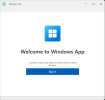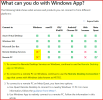End-of-Life for Remote Desktop?
- Thread starter sdkid
- Start date
You are using an out of date browser. It may not display this or other websites correctly.
You should upgrade or use an alternative browser.
You should upgrade or use an alternative browser.
For PC to PC, the Remote Desktop Connection is still functioning fine for me.
For Android (and I think iOS), the former RD App has been replaced by the "Windows App". Apart from having a name that is completely generic and hard to search for, it does still provide the same remote access features.
About the only thing I don't like is it no longer gives a thumbnail of the specific PCs but a generic image representing the OS.

Last edited:
Hmm. I never used the "Remote Desktop" app or "Windows App" (can't ever get over how stupid that name is) from the Microsoft store. Is it meaningfully better than the original "Remote Desktop Connection" program that has been included in Windows for decades? I use Remote Desktop Connection 40 hours a week for remote work.
I actually use lots of different apps for remote computer access, all of them free, and I don't really love any of them. They ALL have pros and cons that make them situationally useful.
Remote Desktop Connection
Pros:
Cons:
MeshCentral
In many ways MeshCentral is like a personal TeamViewer server. It is a self-hosted centralized server for remotely accessing computers.
Pros:
Cons:
VNC
Pros:
Cons:
1remote
This is a third-party client for RDP, VNC, SSH, and more. Has some nice features like the ability to resize a RDP window and have the desktop change its resolution instantly to match. For accessing local machines, I favor this over Microsoft's original Remote Desktop Connection program.
Putty
Putty is my preferred SSH client for accessing linux servers from a Windows machine.
WinSCP
WinSCP can connect to most SSH servers and give you a graphical file management interface.
Haha this post ended up a lot longer than I intended.
I know there are lots of commercial remote access programs out there which work a lot better than open source options. I just can't convince myself to pay for them. My all time favorite remote access program was LogMeIn before they dropped the free tier. It had great ease-of-use, and great performance that scaled well with available bandwidth. Open-source options have never caught up with where LogMeIn was over 11 years ago. After LogMeIn, I switched to TeamViewer for a while. It was distinctly worse than LogMeIn, and as a fairly heavy user they kept flagging my account as being suspected of commercial use and each time I'd have to contact their support to get it unflagged. I dropped them years ago at this point.
I actually use lots of different apps for remote computer access, all of them free, and I don't really love any of them. They ALL have pros and cons that make them situationally useful.
Remote Desktop Connection
Pros:
- RDP (remote desktop protocol) server is built-in to Windows pro editions, just needs turned on.
- Remote Desktop Connection client comes with Windows.
- Good clipboard sharing.
- Good speed, efficiency and frame rate, important for doing remote work.
- Streams audio from the remote machine.
- Can customize the resolution of the remote desktop.
Cons:
- RDP server is not available on Windows Home editions unless you install hacks.
- RDP does not play nice with others. When you connect, it kicks out anyone else who was connected with RDP, and also kicks the local session (the one with a physical monitor, keyboard, mouse) out to the lock screen. Exceptions to this behavior do exist but are poorly implemented and difficult to use.
MeshCentral
In many ways MeshCentral is like a personal TeamViewer server. It is a self-hosted centralized server for remotely accessing computers.
Pros:
- Remote access agents are available for many platforms (Windows, Linux, BSD, Android).
- Can optionally be used via a VPN, but if you expose your server to the internet via port forwarding, then there is no need for firewall or VPN setup on each computer you need to remotely access.
- Free, open source, no arbitrary usage limits on machine count, user count, concurrent session count, etc.
- Remote access is done via a web interface.
- Supports multi-factor authentication.
- Uses peer-to-peer connections when possible via WebRTC protocol, to reduce latency and save on server load/bandwidth.
- Can be used for one-off remote support situations (you send a custom expiring download link to the person needing remote support).
- Very feature-rich, more than just "remote desktop". Example: it has remote file browsing, download/upload capabilities that work independently of remote desktop access.
- It can do remote console (e.g. linux terminal) or remote desktop via its own proprietary protocol, but it also has a browser-based RDP client built in, which you can optionally use with remote machines that have an RDP server turned on.
Cons:
- Bad frame rate capture of the remote desktop when using their proprietary protocol (at least on Windows).
- Poor clipboard sharing support.
- No remote audio.
- Clunky interface for remote desktop. Keyboard typing via their proprietary remote desktop is buggy currently, at least with Windows hosts -- it often misses key combinations like you type
ctrl+ cand it just typescunless you holdctrlfor a longer time before pressingc. And when typing fast it actually can make typos that were not your fault.
VNC
Pros:
- VNC is an open protocol that has been around forever.
- Best cross-platform support.
- There are MANY clients and servers available, both free and paid. My preferred VNC server is TightVNC (on Windows anyway), and for a client I use RealVNC Viewer.
Cons:
- Baseline VNC implementations lack features (audio, advanced clipboard sharing, etc).
- Bad performance especially on very low bandwidth, so I mainly use it as a backup in case other remote access methods are not working.
1remote
This is a third-party client for RDP, VNC, SSH, and more. Has some nice features like the ability to resize a RDP window and have the desktop change its resolution instantly to match. For accessing local machines, I favor this over Microsoft's original Remote Desktop Connection program.
Putty
Putty is my preferred SSH client for accessing linux servers from a Windows machine.
WinSCP
WinSCP can connect to most SSH servers and give you a graphical file management interface.
Haha this post ended up a lot longer than I intended.
I know there are lots of commercial remote access programs out there which work a lot better than open source options. I just can't convince myself to pay for them. My all time favorite remote access program was LogMeIn before they dropped the free tier. It had great ease-of-use, and great performance that scaled well with available bandwidth. Open-source options have never caught up with where LogMeIn was over 11 years ago. After LogMeIn, I switched to TeamViewer for a while. It was distinctly worse than LogMeIn, and as a fairly heavy user they kept flagging my account as being suspected of commercial use and each time I'd have to contact their support to get it unflagged. I dropped them years ago at this point.
Okay, I just downloaded the "Microsoft Remote Desktop" app and the newer "Windows App" app.
Yikes.
"Microsoft Remote Desktop" is slower than the original Remote Desktop Connection and seems to offer no reason whatsoever for me to switch to it. But it is, at least, what it claims to be. A more modern version of Remote Desktop Connection.
"Windows App" is a whole new horror. It was touted as the replacement for remote desktop connection. What a joke. "Windows App" isn't even a remote desktop client. It is a client for certain cloud virtual machines rented from Microsoft/Azure. That appears to be all. You can't use it to connect to a PC you own.
Yikes.
"Microsoft Remote Desktop" is slower than the original Remote Desktop Connection and seems to offer no reason whatsoever for me to switch to it. But it is, at least, what it claims to be. A more modern version of Remote Desktop Connection.
"Windows App" is a whole new horror. It was touted as the replacement for remote desktop connection. What a joke. "Windows App" isn't even a remote desktop client. It is a client for certain cloud virtual machines rented from Microsoft/Azure. That appears to be all. You can't use it to connect to a PC you own.
I'm using Windows App to connect to my home PCs (see my earlier screenshot). You still need a way to VPN to your home network if you want remote access.Okay, I just downloaded the "Microsoft Remote Desktop" app and the newer "Windows App" app.
Yikes.
"Microsoft Remote Desktop" is slower than the original Remote Desktop Connection and seems to offer no reason whatsoever for me to switch to it. But it is, at least, what it claims to be. A more modern version of Remote Desktop Connection.
"Windows App" is a whole new horror. It was touted as the replacement for remote desktop connection. What a joke. "Windows App" isn't even a remote desktop client. It is a client for certain cloud virtual machines rented from Microsoft/Azure. That appears to be all. You can't use it to connect to a PC you own.
And yes, local RDC access also works and won't go away.
They must have hidden it then. hmm.I'm using Windows App to connect to my home PCs (see my earlier screenshot). You still need a way to VPN to your home network if you want remote access.
And yes, local RDC access also works and won't go away.
Devices > Add (+) > PC ConnectionsThey must have hidden it then. hmm.
elvisimprsntr
Getting comfortable
I use the Windows app on my Mac to connected to Windows VMs.
For the most part is is the same as RDP.
For the most part is is the same as RDP.
biggen
Known around here
- May 6, 2018
- 2,819
- 3,223
I installed Windows App again. Still no way to add any devices. Everything about this screams to me "this is just an MS cloud product client".
Maybe you guys successfully using it for local connections are using a different version from somewhere? This is just what I get when I install Windows App from the microsoft store on Win11.


Maybe you guys successfully using it for local connections are using a different version from somewhere? This is just what I get when I install Windows App from the microsoft store on Win11.


This behavior (cloud-access only) seems to be intentional only from the Windows client and web client. Evidently mac and mobile clients can connect to things you actually own. But not the Windows version for some reason?



What is Windows App? - Windows App
Learn about Windows App, which can connect to Azure Virtual Desktop, Windows 365, Microsoft Dev Box, Remote Desktop Services, and a remote PC.
learn.microsoft.com

I'm still using RDC for access from other PCs. But for mobile devices, you must switch to the "Windows App".This behavior (cloud-access only) seems to be intentional only from the Windows client and web client. Evidently mac and mobile clients can connect to things you actually own. But not the Windows version for some reason?

What is Windows App? - Windows App
Learn about Windows App, which can connect to Azure Virtual Desktop, Windows 365, Microsoft Dev Box, Remote Desktop Services, and a remote PC.learn.microsoft.com
View attachment 221259

